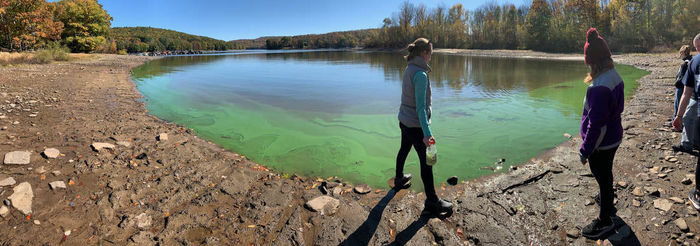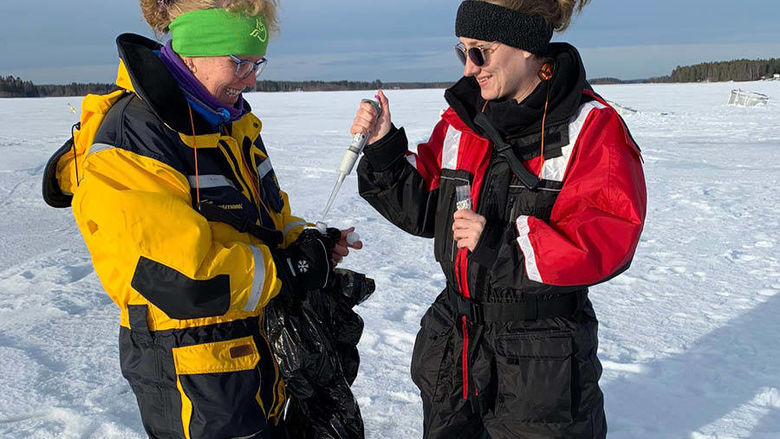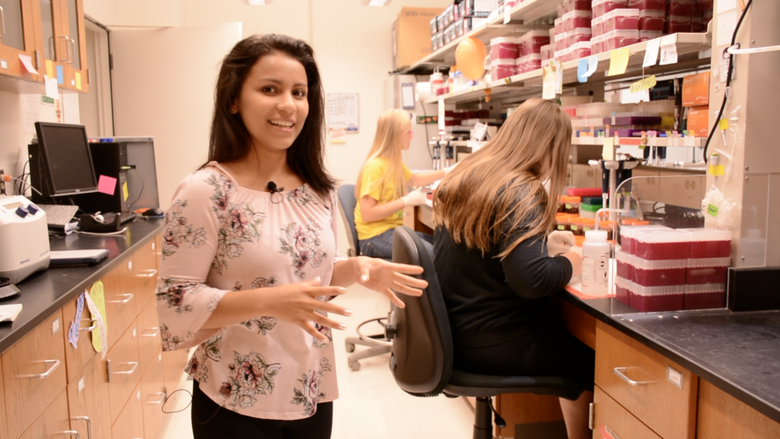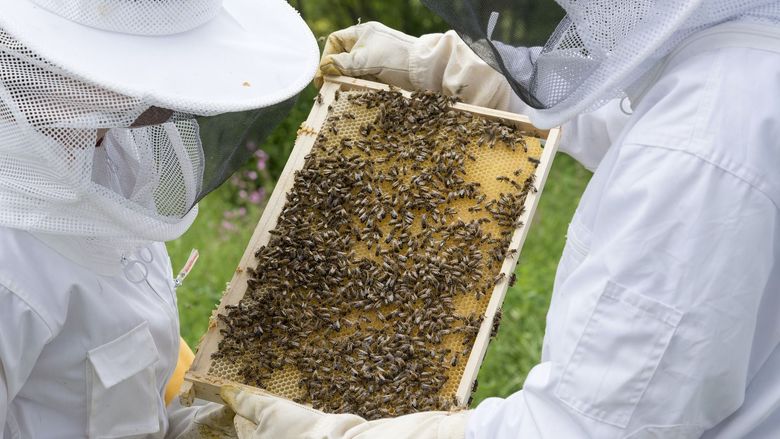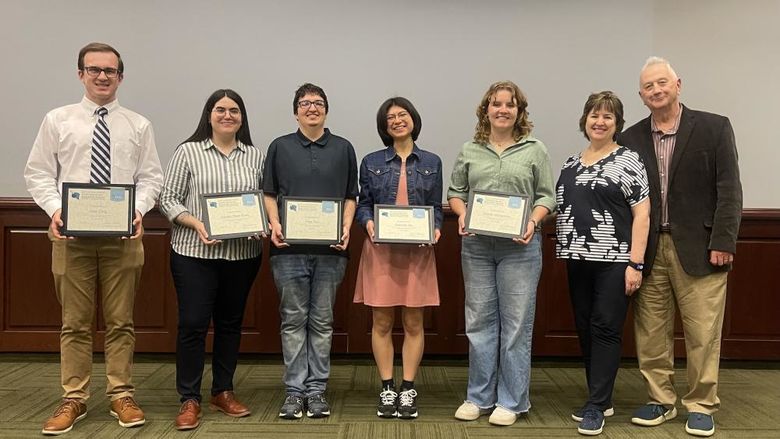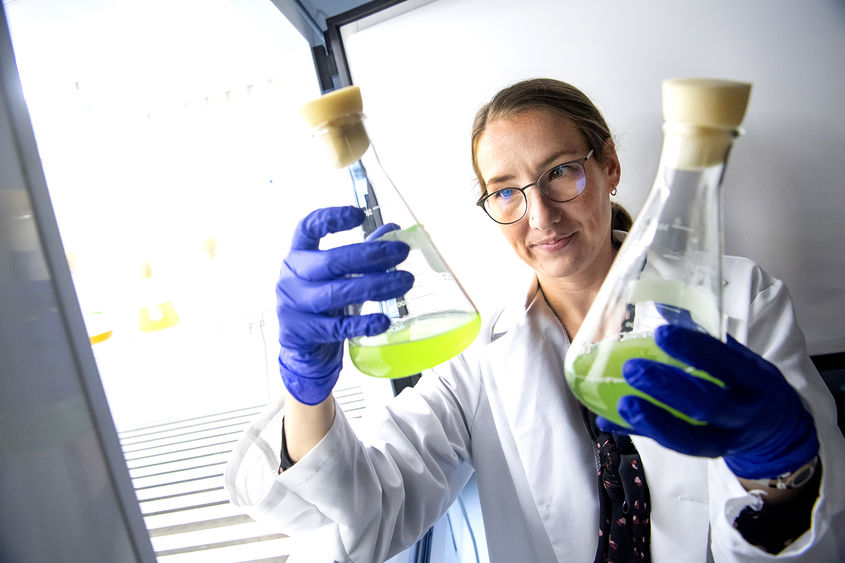
Sarah Princiotta, assistant professor of biology, at Penn State Schuylkill.
SCHUYLKILL HAVEN, Pa. — Sarah Princiotta, assistant professor of biology, has been putting algae and cyanobacteria, or blue-green algae, under the microscope since an undergraduate ecology course revealed to her the highly complex and fascinating world of single-celled aquatic organisms.
Fed by warming temperatures and human-produced nitrogen and phosphorous pollution, these overgrowths of algae and blue-green algae are harmful to freshwater ecosystems and deadly to aquatic life through, primarily, the depletion of oxygen. The resulting odorous foam, froth, and oil-like slicks from a bloom can make water unfit even for recreational use.
Additionally, algal blooms created by certain species of blue-green algae or cyanobacteria can potentially produce harmful toxins. These cyanotoxins negatively impact public health and have been associated with domestic animal and wildlife death.
Enter Sarah Princiotta, assistant professor of biology at Penn State Schuylkill, whose current research focuses on the dynamics of trophic, or food chain, relationships of phytoplankton in freshwater microbial communities, along with known environmental stressors — including changes in global climate —to understand how these communities change over time. This research may prove critical to predicting and controlling the proliferation of potentially toxic blooms.
An early interest in science
Princiotta's interest in ecological and biological systems began during her childhood in southern New Jersey. Her love of the outdoors and curiosity about natural systems and organisms was encouraged by her parents and great-grandparents on whose 30-acre ecosystem — including a lake, orchards, cranberry bog, and various gardens — Princiotta passed many summer days.
"My parents encouraged me to explore the outdoors, where I spent a lot of time as a child,” Princiotta recalled. “My mother took my sister and me to the beach almost every afternoon, and I was fascinated by the activity of horseshoe crabs and sand fleas."
Then, while working toward her bachelor’s degree at Temple University, Princiotta participated in the undergraduate research program under the mentorship of her biology professor, Robert Sanders. Studying the ecology of algae found exclusively in Antarctica provided Princiotta her first encounter with mixotrophic organisms. Mixotrophic organisms are both photosynthetic (acquiring energy from the sun) and heterotrophic (using preformed organic compounds as a source of energy or food).
This undergraduate project stirred Princiotta’s scientific interests and proved to be a pivotal beginning for the trajectory her research would follow.
Creating new knowledge
“When that project ended, I stayed on at Temple to complete a Ph.D. thesis on the ecology and physiology of mixotrophic protists,” explained Princiotta. “What was especially exciting about this field of research was that it wasn’t even in the textbooks at this point.”
When Princiotta was ready to explore post-graduate opportunities, finding an institution where she could maintain an active research program while still teaching was critical. She found what she described as the “best of both worlds” at Penn State Schuylkill.
Further, Princiotta said she enjoys the small class sizes and intimate feel of the Schuylkill campus. “As an instructor, I get to know my students on a personal level,” said Princiotta. “They aren’t just a face in the crowd.”
When Princiotta isn’t in the classroom or conducting fieldwork, you can find her out on the trail with her husband and their spaniel, Penny. We caught up with Princiotta recently to talk more about the nature of her research and its potential real-world impact.
Q: Why algae?
Princiotta: Before working on my undergraduate research project, I assumed that all organisms were either photosynthetic or heterotrophic, but the algae that I was working with from Antarctica were mixotrophic and used both forms of nutrition, sometimes simultaneously and sometimes switching back and forth. This strategy could be especially important for algae that must endure the austral winter when there are 24 hours of continuous darkness for several months.
So, discovering this microscopic world was really eye-opening and exciting.
Q: Tell us more about algal and cyanobacterial blooms. And why understanding them is so important.
Princiotta: A “bloom” occurs when a dense population of cells forms in the water, often choking out the natural biodiversity. Different species of algae and cyanobacteria will form these dense proliferations. Understanding the drivers of bloom formation are important because there are several negative consequences that can result, including massive depletions in oxygen that harm aquatic life.
One of the most critical consequences of a cyanobacterial bloom is that some species can produce toxic compounds. The consumption of contaminated freshwater can cause illness in humans or death of domestic animals. Although the formation of cyanobacterial blooms isn’t a new phenomenon, they are becoming increasingly common across the world.
Q: What surprised you the most as you began this line of research?
Princiotta: The cool thing about my job is that I am constantly surprised. Something that drew me into this research was the idea that mixotrophic nutrition isn’t “one size fits all.” There is a gradient of trophic strategies. Some mixotrophs are more photosynthetic and rely more on ingestion of bacteria when there isn’t ample light. Some mixotrophs are more predatory and rely on photosynthesis when there isn’t enough particulate food.
Q: Why are trophic interactions central to your research?
Princiotta: Trophic interactions refer to the feeding habits between organisms. I am particularly interested in protists (single-celled organisms) that ingest bacteria. These bacterivores play critical roles in the aquatic food web as a resource for zooplankton (planktonic animals) and top-down regulators of bacterial abundance.
Put more simply, what something eats and when they choose to eat it has HUGE implications for the way energy-rich carbon moves between living organisms and their environment. It can also determine where an organism can live within its environment and how well it performs physiologically.
Q: Can you tell us a little bit about your research findings so far?
Princiotta: Most of my research focuses on the role of mixotrophic protists that combine photosynthesis with predatory ingestion of bacteria. I am especially interested in how trophic interactions, or feeding relationships, act as a structuring force for the planktonic community.
More recently, I’ve pivoted to the role that mixotrophic protists might have as predators of potentially toxic cyanobacteria (photosynthetic bacteria). My most recent work demonstrates that a species of mixotrophic protist can lead to a reduction in toxins produced and accumulated in a common form of cyanobacteria.
Q: What are the practical applications of your recent findings?
Princiotta: During my postdoctoral studies, I completed lab work that suggested mixotrophic protists can ingest and biodegrade cyanotoxins. My work, along with that of others, supports the idea that an understanding of cyanobacterial bloom dynamics requires a holistic view of aquatic ecosystems. We need to consider conditions such as excess nutrients and surface water warming, as well as the community of microbes that cooccur with these cyanobacteria.
My hope is that we can use planktonic community analysis as a predictive tool, in conjunction with an understanding of environmental conditions, to predict if a cyanobacteria bloom may occur. Prior to beginning my position at Penn State Schuylkill in 2018, I was director of research and education for Lacawac Sanctuary and Biological Field Station. During my time there, I worked with a team to develop a regional lake monitoring program for the Pocono region of Pennsylvania. The new station director, Dr. Beth Norman, and I worked together to fund a project that will leverage this monitoring program to address the biological drivers of cyanotoxin production.
The goal of this project is to collect field data to see if analysis of the microbial community can be used to predict if a lake is susceptible to a cyanobacterial bloom event. We will also put into practice some of the work I've done in the lab to show that certain mixotrophic protists are able to ingest and biodegrade cyanotoxins.
Q: What student research opportunities do you offer?
Princiotta: I am looking for motivated students who are willing to work hard both on field and lab work. In addition, the student must be willing to communicate their work to community members who are participating in the lake sampling program. The most important qualities that I am looking for in an undergraduate research intern are passion and motivation. Ideally, the intern will have completed BIOL 110. Anyone who would like more information can reach me by email: [email protected].
Learn more about Sarah Princiotta’s current research, or follow her on Twitter for updates and timely information on aquatic microbiology.
Learn more about academic programs, including biology, at Penn State Schuylkill.
